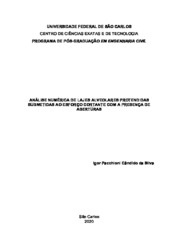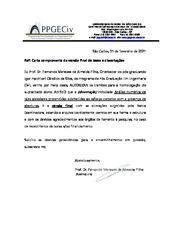Mostrar el registro sencillo del ítem
Análise numérica de lajes alveolares protendidas submetidas ao esforço cortante com a presença de aberturas
| dc.contributor.author | Silva, Igor Pacchioni Cândido da | |
| dc.date.accessioned | 2021-02-09T11:37:42Z | |
| dc.date.available | 2021-02-09T11:37:42Z | |
| dc.date.issued | 2020-12-11 | |
| dc.identifier.citation | SILVA, Igor Pacchioni Cândido da. Análise numérica de lajes alveolares protendidas submetidas ao esforço cortante com a presença de aberturas. 2020. Dissertação (Mestrado em Engenharia Civil) – Universidade Federal de São Carlos, São Carlos, 2020. Disponível em: https://repositorio.ufscar.br/handle/ufscar/13828. | * |
| dc.identifier.uri | https://repositorio.ufscar.br/handle/ufscar/13828 | |
| dc.description.abstract | The use of prestressed precast hollow core slabs has intensified as technological advances, and as part is manufactured in industry, this element needs adjustments during its application, as for example, when need openings in the hollow core panels. Therefore, the presente study aims to analyze the structural behavior of the shear test of prestressed hollow core slabs with front openings. For that, a methodology for the shear test was proposed with the ABAQUS® software using the finite element method, seeking the total representation of the manufacturing process and loading of the hollow core panel, from the prestressing application step, prestressing step and final loading step, using the tools available in the software for this. Initially, a reference hollow core slab without openings was modeled for the validation of the methodology and later the methodology was applied to hollow core slabs with central and lateral opening, comparing the results according to experimental studies already presented in the national technical literature. In this way, it was possible to understand the behavior of hollow core slabs with front openings when subjected to the shear test. Finally, the results demonstrated that the openings significantly influence the redistribution of the stresses of the web, and for the hollow core slab with central opening the rupture occurred in the web adjacent to the opening, and for the hollow core slab with lateral opening the rupture occurred in the web the end. Therefore, it was possible to conclude that the openings intensify the main tension stresses of the webs, being responsible for the diagonal tension rupture of the models, in addition to decreasing the resistant capacity of the panels by 27.25% for the case of the central opening and 50, 22% for the most critical case of the lateral opening. | eng |
| dc.description.sponsorship | Não recebi financiamento | por |
| dc.language.iso | por | por |
| dc.publisher | Universidade Federal de São Carlos | por |
| dc.rights | Attribution-NonCommercial-NoDerivs 3.0 Brazil | * |
| dc.rights.uri | http://creativecommons.org/licenses/by-nc-nd/3.0/br/ | * |
| dc.subject | Laje alveolar | por |
| dc.subject | Concreto pré-fabricado | por |
| dc.subject | Protensão | por |
| dc.subject | Método dos elementos finitos | por |
| dc.subject | Comportamento estrutural | por |
| dc.subject | Força cortante | por |
| dc.subject | Hollow core slab | eng |
| dc.subject | Precast concrete | eng |
| dc.subject | Prestressing | eng |
| dc.subject | Finite element method | eng |
| dc.subject | Shear Force | eng |
| dc.subject | Structural behavior | eng |
| dc.title | Análise numérica de lajes alveolares protendidas submetidas ao esforço cortante com a presença de aberturas | por |
| dc.title.alternative | Numerical analysis of prestressed hollow core slabs submitted to shear test with the openings | eng |
| dc.type | Dissertação | por |
| dc.contributor.advisor1 | Almeida Filho, Fernando Menezes de | |
| dc.contributor.advisor1Lattes | http://lattes.cnpq.br/0447825383222965 | por |
| dc.description.resumo | O uso das lajes alveolares pré-fabricadas protendidas tem se intensificado à medida em que ocorre o avanço tecnológico na construção civil, e desta forma por se tratar de uma peça pré-fabricada, este elemento, por diversas vezes, precisa de ajustes durante sua aplicação, como por exemplo, durante a realização de aberturas nos painéis alveolares. Sendo assim, o objetivo deste trabalho é analisar o comportamento estrutural do ensaio à força cortante de lajes alveolares protendidas com aberturas de extremidade. Para isso, foi idealizada uma metodologia para a simulação do ensaio à força cortante com a utilização do software ABAQUS® por meio do método dos elementos finitos, buscou-se a representação total do processo de fabricação e carregamento do painel alveolar, desde a etapa de aplicação da protensão, etapa de liberação da protensão até a etapa final de carregamento, utilizando as ferramentas disponíveis no software para isso. Inicialmente modelou-se uma laje alveolar de referência, sem aberturas, para a validação da metodologia e posteriormente aplicou-se a metodologia nas lajes alveolares com abertura central e de extremidade, realizando a comparação dos resultados conforme estudos experimentais já apresentados na literatura técnica nacional. Desta maneira, foi possível compreender o comportamento dos painéis alveolares com aberturas de extremidade quando submetidos ao ensaio à força cortante. Por fim, os resultados apresentados demonstraram que as aberturas influenciam significativamente na redistribuição dos esforços das nervuras, sendo que para a laje alveolar com abertura central a ruptura ocorreu na nervura adjacente à abertura. E para a laje alveolar com abertura lateral a ruptura ocorreu na nervura da extremidade. Logo, foi possível concluir que as aberturas intensificam as tensões principais de tração das nervuras, sendo elas responsáveis pela ruptura por tração diagonal dos modelos, além de diminuírem a capacidade resistente dos painéis em 27,25% para o caso da abertura central e 50,22% para o caso mais crítico da abertura lateral. | por |
| dc.publisher.initials | UFSCar | por |
| dc.publisher.program | Programa de Pós-Graduação em Engenharia Civil - PPGECiv | por |
| dc.subject.cnpq | ENGENHARIAS::ENGENHARIA CIVIL::ESTRUTURAS | por |
| dc.subject.cnpq | ENGENHARIAS::ENGENHARIA CIVIL | por |
| dc.publisher.address | Câmpus São Carlos | por |
| dc.contributor.authorlattes | http://lattes.cnpq.br/4526141281957025 | por |


